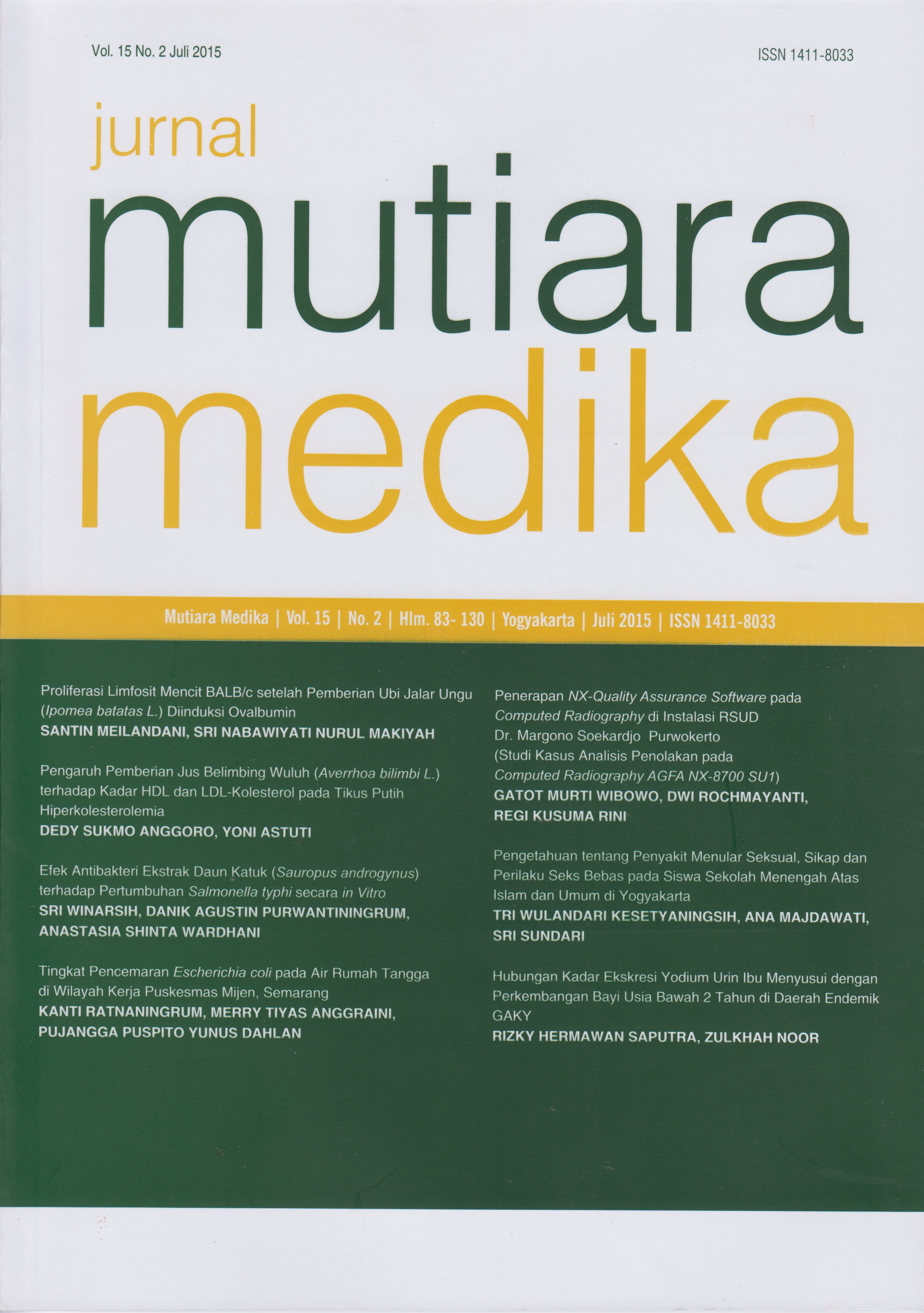Hubungan Kadar Ekskresi Yodium Urin Ibu Menyusui dengan Perkembangan Bayi Usia Bawah 2 Tahun di Daerah Endemik GAKY
DOI:
https://doi.org/10.18196/mmjkk.v15i2.3759Keywords:
Iodine Deficiency Disorder (IDD), Urine Iodine Excretion (UIE), Development of Baby, Iodine, Induced Hypertiroidism (IIH), Gangguan akibat kekurangan yodium (GAKY), Ekskresi yodium urin (EYU), Perkembangan Bayi, Iodine Induced Hypertiroidism (IIH)Abstract
Gangguan akibat kekurangan yodium (GAKY) pada bayi berdampak menghambat proses tumbuh kembang. Penelitian ini bertujuan untuk mengetahui hubungan kadar ekskresi yodium urin (EYU) ibu menyusui dengan perkembangan bayi usia dibawah dua tahun di daerah endemik GAKY. Penelitian ini bersifat observational dengan desain cross sectional. Sampel penelitian adalah 30 ibu menyusui yang memiliki bayi berusia dibawah dua tahun. Kadar EYU diukur dengan menggunakan Ammonium Persulfat Dry Digestion dan Perkembangan bayi dinilai dengan menggunakan Kuesioner Pra Skrining Perkembangan (KPSP). Kadar median EYU ibu kemudian dikorelasikan dengan status perkembangan bayi, menggunakan uji Spearman. Hasil menunjukkan bahwa kadar EYU ibu optimal (173,5 ppm). Sebanyak sembilan ibu (30%) memiliki status EYU optimal, namun status perkembangan bayi dengan kategori meragukan sebanyak 12 bayi (40%). Hasil uji korelasi antara kadar EYU ibu dengan status perkembangan bayi menunjukkan p = 0,428; r = 0,150. Disimpulkan bahwa tidak terdapat hubungan yang bermakna antara kadar EYU ibu menyusui dengan status perkembangan bayi usia dibawah dua tahun.Disorders due to iodine deficiency (GAKY) in infants have an effect inhibit the growth and development processes. This study aims to determine the relationship of urinary iodine excretion (UIE) of breastfeeding mothers with the development of infants aged under two years in the endemic areas of GAKY. This research is observational with cross sectional design. The sample was 30 breastfeeding mothers with babies under two years old. Urinary iodine excretion levels were measured using Dry Digestion Ammonium Persulfate and Infant Development were assessed using a Pre-Screening Appraisal Questionnaire (KPSP). The maternal UIE median level was then correlated with the infant’s developmental status, using the Spearman test. The results showed that the mother’s UIE level was optimal (173,5 ppm). There were nine mothers (30%) had optimal UIE status, but infant development status in the dubious category of 12 (40%). Result of correlation test between mother UIE level with infant development status showed p = 0,428; r = 0.150. It was concluded that there was no significant association between UIE of breastfeeding mothers and developmental status of infants aged under two years.
References
Depkes. Gangguan Akibat Kurang Yodium. Diakses 15 November 2011, dari http://gizi.depkes.go.id/gaky/lb-gaky.pdf
Indriastuti, W. Gangguan Akibat Kurang Yodium. 2008. Diakses 15 November 2011, dari http://blogsiez.blogspot.com/2008/01/gangguan-akibat-kekurangan-yodium-gaky.html
WHO. Assesment of Iodine Deficiency Disorder and Monitoring Their Elimination, A Guide for Programme Managers, 2nd edition. 2001.
Muhilal. Perubahan Kandungan Yodium dalam ASI setelah Pemberian Yodium Dosis Tinggi per Oral pada Ibu Menyusui. Jakarta: Balai Litbang Kesehatan. 2003.
Pardede, LVH., Hardjowasito,W., Gross, R., Dillon, DHS., Totoprajogo, OS., Yosoprawoto, M., et al. Urinary Iodine Excretion is The Most Appropriate Outcome Indicator for Iodine Deficiency at Field Conditions at District Level. J. Nutr; 1998. 128 (7): 1122-1126.
Budiman, B. Risiko Menjadi Kretin pada Bayi yang Menderita Gangguan Neurologik di Daerah Endemik GAKY dalam Kurun Waktu Lima Tahun. 2002. Diakses pada 22 April 2011 dari http://digilib.litbang.depkes.go.id/ go.php?id=jkpkbppk-gdl-res-2002-basuki-1448gaki&q=gaki
Widodo, U. Kelainan Kongenital dan Hambatan Tumbuh Kembang Anak di Kecamatan Srumbung, Kabupaten Magelang. 2004. Diakses 15 November 2011, dari http:// www.litbang.depkes.go.id/-download/ penelusuran/abstrak/Abstrak2004.pdf
Depkes RI. Pedoman Pelaksanaan, Stimulasi, Deteksi dan Intervensi Dini Tumbuh Kembang Anak di Tingkat Pelayanan Kesehatan Dasar. Jakarta: Departemen Kesehatan RI. 2010.
Kusmil, R. Pertumbuhan dan Perkembangan Anak. 2008. Diakses 15 November 2011, dari http://www.aqila-putri.rachdian.com/content/ view/23/29/1/1/
Chamidah, A.N. Deteksi Dini Gangguan Pertumbuhan dan Perkembangan Anak. Jurnal Pendidikan Khusus. 2009. 1 (3): 83-93
Downloads
Issue
Section
License
Copyright
Authors retain copyright and grant Mutiara Medika: Jurnal Kedokteran dan Kesehatan (MMJKK) the right of first publication with the work simultaneously licensed under an Attribution 4.0 International (CC BY 4.0) that allows others to remix, adapt and build upon the work with an acknowledgment of the work's authorship and of the initial publication in Mutiara Medika: Jurnal Kedokteran dan Kesehatan (MMJKK).
Authors are permitted to copy and redistribute the journal's published version of the work (e.g., post it to an institutional repository or publish it in a book), with an acknowledgment of its initial publication in Mutiara Medika: Jurnal Kedokteran dan Kesehatan (MMJKK).
License
Articles published in the Mutiara Medika: Jurnal Kedokteran dan Kesehatan (MMJKK) are licensed under an Attribution 4.0 International (CC BY 4.0) license. You are free to:
- Share — copy and redistribute the material in any medium or format.
- Adapt — remix, transform, and build upon the material for any purpose, even commercially.
This license is acceptable for Free Cultural Works. The licensor cannot revoke these freedoms as long as you follow the license terms. Under the following terms:
Attribution — You must give appropriate credit, provide a link to the license, and indicate if changes were made. You may do so in any reasonable manner, but not in any way that suggests the licensor endorses you or your use.
- No additional restrictions — You may not apply legal terms or technological measures that legally restrict others from doing anything the license permits.






